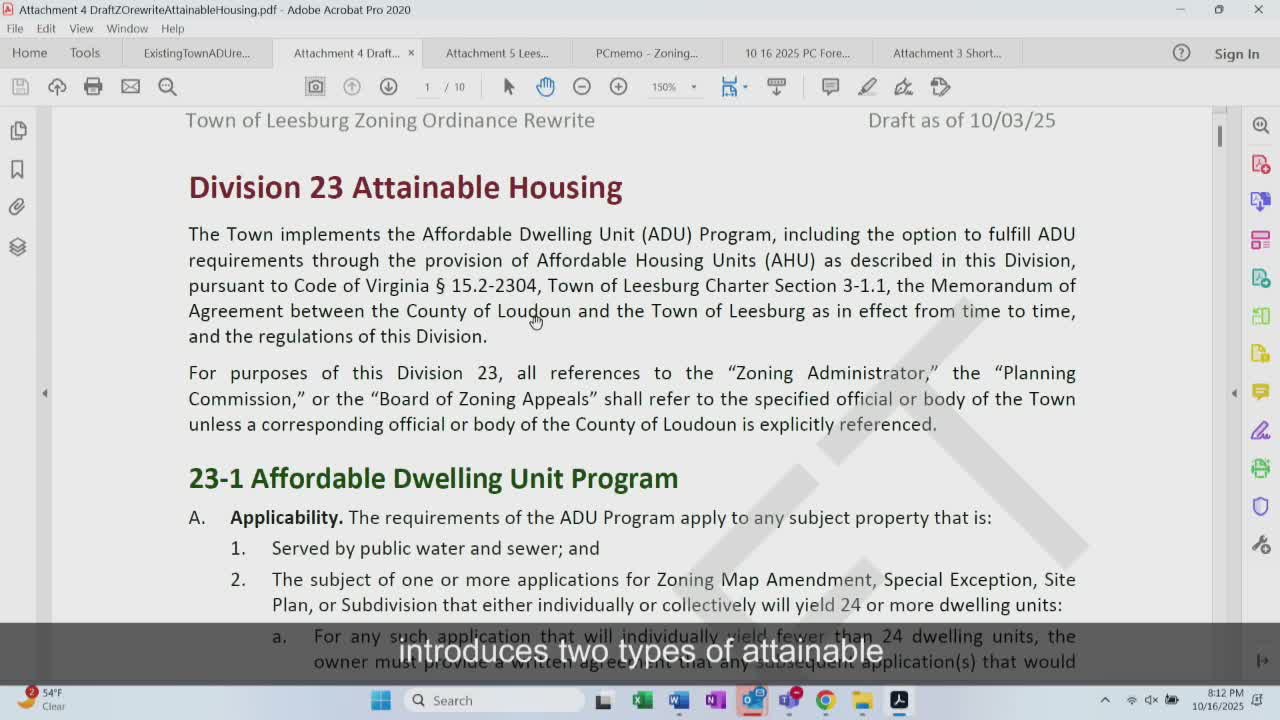Commission debates ADU/AHU rules, sets subcommittee to refine attainable‑housing language
October 16, 2025 | Leesburg, Loudoun, Virginia
This article was created by AI summarizing key points discussed. AI makes mistakes, so for full details and context, please refer to the video of the full meeting. Please report any errors so we can fix them. Report an error »

Planning staff walked the commission through the draft attainable‑housing language. The draft retains the town’s existing Affordable Dwelling Unit (ADU) program (administered through an MOU with Loudoun County) and adds a separate category—Affordable Housing Units (AHUs)—to accommodate state‑funded, programmatic affordable projects that have distinct deed‑restriction and program requirements.
Key proposed changes include increasing the local ADU minimum to 15% of units for qualifying developments regardless of housing type (the draft diverges from Loudoun County’s differentiated rates of 10% multifamily / 15% single‑family). Staff said the AHU language would allow projects meeting state AHU program rules (for example, projects seeded by HUD/state financing that have stricter deed restrictions) to be counted toward the ADU requirement.
Commissioners probed several implementation details, including the ADU trigger (the draft applies to developments of 24 or more units), how AMI bands are set (ADU income targeting was presented as county program income guidelines, typically 30–50% AMI rental and 30–70% AMI for ownership depending on program), the MOU with Loudoun County that currently governs ADU administration and a 120‑unit cap in the MOU, and the town’s available land and infrastructure constraints for higher density. Vice Chair Campbell and other commissioners raised concerns about parking, amenity requirements and whether the town’s memorandum with the county needs updating to support a higher ADU percentage.
Action: the commission formed a small subcommittee (Vice Chair Campbell, Commissioners Candace and Ron, and staff including Miss Newton) to refine the attainable‑housing language, review the county MOU and report back at the commission’s December meeting with recommended edits and implementation options.
Staff said they would provide the commission with a focused memo showing current ADU counts in town, the specifics of the county MOU, and examples (including a previously proposed Oak Lawn/AHU project) to illustrate how AHU funding rules differ from ADU rules. Commissioners asked staff to analyze amenity, parking and infrastructure implications before finalizing any higher ADU percentage.
Key proposed changes include increasing the local ADU minimum to 15% of units for qualifying developments regardless of housing type (the draft diverges from Loudoun County’s differentiated rates of 10% multifamily / 15% single‑family). Staff said the AHU language would allow projects meeting state AHU program rules (for example, projects seeded by HUD/state financing that have stricter deed restrictions) to be counted toward the ADU requirement.
Commissioners probed several implementation details, including the ADU trigger (the draft applies to developments of 24 or more units), how AMI bands are set (ADU income targeting was presented as county program income guidelines, typically 30–50% AMI rental and 30–70% AMI for ownership depending on program), the MOU with Loudoun County that currently governs ADU administration and a 120‑unit cap in the MOU, and the town’s available land and infrastructure constraints for higher density. Vice Chair Campbell and other commissioners raised concerns about parking, amenity requirements and whether the town’s memorandum with the county needs updating to support a higher ADU percentage.
Action: the commission formed a small subcommittee (Vice Chair Campbell, Commissioners Candace and Ron, and staff including Miss Newton) to refine the attainable‑housing language, review the county MOU and report back at the commission’s December meeting with recommended edits and implementation options.
Staff said they would provide the commission with a focused memo showing current ADU counts in town, the specifics of the county MOU, and examples (including a previously proposed Oak Lawn/AHU project) to illustrate how AHU funding rules differ from ADU rules. Commissioners asked staff to analyze amenity, parking and infrastructure implications before finalizing any higher ADU percentage.
View full meeting
This article is based on a recent meeting—watch the full video and explore the complete transcript for deeper insights into the discussion.
View full meeting
